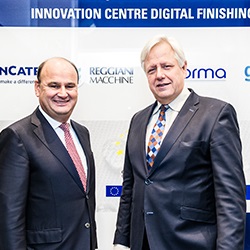Fewer chemicals for textile printing
Could textile printing be on the verge of a major breakthrough? For years, conventional processes — known as rotary screen printing — have required a high amount of chemicals to be applied on the textile, involving excessive amounts of water and energy. The process involves a different screen for each colour required in the final design, and a certain amount of print paste needs to be produced to ensure quality throughout the whole lot. This paste remains in the screens, eventually becomes waste and has to be cleaned using water, which then needs to be treated. In total, it is estimated that 90 % of chemicals used in dyeing operations do not stay on the fibre. With inkjet methods, on the other hand, these forms of vast waste are no longer created: the only waste remaining is linked to the maintenance of the print heads. This method has been entering the textile process market progressively over the past few years, but technical limitations have prevented a widespread market adoption. Speeds were limited to maximal 5 m/min due to required intermitting operation being used in most existing digital textile printers. This pales in comparison to traditional finishing process speeds reaching up to 40 m/min. By joining forces with machine supplier Reggiani Macchine, TenCate has come up with a new high-speed inkjet technology which promises to remove all obstacles to the large-scale adoption of digital textile printing (and finishing). The DIGIFIN (DIGItal finishing with High Speed Inkjet technology, significantly improving sustainability, flexibility and economic performance of the textile FINishing industry) project, which ended in July, has not only demonstrated the technical and industrial reliability of inkjet technology for economically feasible applications: its technology also outperforms traditional processes from a technical, economical and environmental perspective. Gerrit Koele, coordinator of the project and managing director of TenCate Digital Finishing, told us about the first products to be commercialised based on this technology and how it will completely reshape the value chain. How do you explain the current lack of industry interest into digital finishing? I wouldn’t say there is no interest. I think the interest in digital finishing is there and growing, but it fails to materialise because of two main reasons. First, most digital printer OEMs mostly concentrate on printing colours and do not know much about textile finishing. Next, existing printers are all Drop on Demand (DOD) printing techniques, which means they use a minimum quantity of finishers. In order to have better finishing we would need better coating systems, like the ISIS inkjet printing system formerly developed by Osiris, whose activities are now continued by TenCate. What would you say are the main strengths of inkjet technology compared to alternatives? From a production point of view inkjet is a minimum application technology, which means, more concretely, that it makes it possible to dose very precisely the needed amounts of chemicals. When printing we therefore have the possibility to use CMYK. Although this looks very much the same as standard printing to laypeople, from a technical point of view this is completely and fundamentally different. Can you tell us more about the environmental benefits of this technology? DIGIFIN-based technology is a major technological innovation from an ecological point of view. The environmental benefits — which include reduced energy and water consumption, but also less pollution — arise from the fact that we are able to reproduce technical textiles with the same printing quality that we can see with current technologies, but we achieve this by using less than 10% of the chemicals used normally. With existing foulard techniques we need a mix of all kinds of chemicals to achieve our technical textile printing goals, whereas by resorting to digital printing we use pretty much only the functional chemicals themselves. The project focuses on the outdoor textiles market. Why this choice? What kind of applications have you developed so far? We have chosen the outdoor applications market after much reflection, because switching to digital finishing will not only change the production technology, but also the habits of our customers, the manufacturers, the end-users and even ourselves and our processes. The whole value chain will be affected by this change, and I would say this is really a new industrial revolution in its own right for the sector. The main advantage of choosing outdoor products such as tent and shade fabrics is that everyone will be able to see the benefits of going digital, so it seemed to be an easier and more natural choice than our next targets, such as finishing single-sided hydrophilic, etc. So you intend to keep expanding the range of DIGIFIN products? Yes, the aim is absolutely to expand our range of digitally finished products, and in this way to create a new line of products fulfilling the current and future customer needs and requirements while offering infinite marketing possibilities and boasting important environmental advantages. Are you happy with market reception so far? We are very happy with the market reception, although we had to resort to a marketing push towards end-users before our actual customers, the manufacturers, actually took interest and eventually became very enthusiastic about our technology. Our solution is a breakthrough innovation, so people have to get used to a brand new reality. That takes time. When can we expect the first DIGIFIN-based products to become available? The first DIGIFIN-based product is already on the market, as our ‘digitally-printed sun awning’ and ‘digitally-printed tent’ fabrics are already available and already being sold to our customers in Europe. Will you keep on developing DIGIFIN-based products in the future? If so, what are your plans? We will absolutely keep developing our range of digitally-printed and digitally-finished products in the future, actually we even think that our near future will completely change because of this. We are working on three new products but unfortunately I cannot disclose any more information at the moment. DIGIFIN Funded under FP7-ICT project website
Countries
Netherlands



